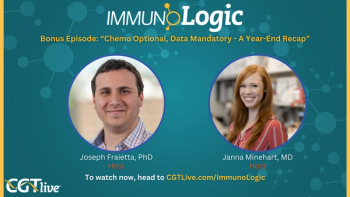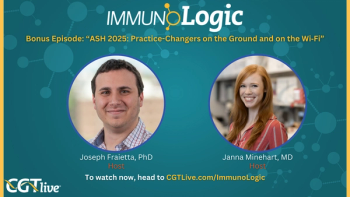
Axi-Cel Superior to SOC in Elderly Patients with Diffuse Large B-Cell Lymphoma
Jason Westin, MD, FACP, leader, DLBCL research team, MD Anderson Cancer Center, discussed results from the ZUMA-7 trial at ASCO 2022.
“For patients with relapsed refractory diffuse large B cell lymphoma, one of the big unmet needs is what to do for patients who are frail...The ability for us to deliver a therapy such as CAR T-cell in a patient population that historically has been considered as potentially not eligible for transplant would be a very important unmet need for us to define with this clinical trial.”
Axicabtagene ciloleucel (axi-cel; Yescarta; Kite) has demonstrated superiority to standard-of-care (SOC) chemotherapy in patients with relapsed/refractory diffuse large B-cell lymphoma (DLBCL) over the age of 65 years, according to new data from the ZUMA-7 study (NCT03391466).
These data were presented at the
ZUMA-7 has enrolled 109 elderly patients as of March 18, 2021, 51 to the axi-cel arm and 58 to the SOC arm. Participants in the axi-cel arm had a median age of 70 years (range, 65-80) and participants in the SOC arm had a median age of 69 years (range, 65-81). The axi-cel arm had more participants with high-risk features, including second-line adjusted International Prognostic Index scores of 2-3 in 53% of participants and elevated lactate dehydrogenase in 61% of participants, compared with 31% and 41% in the SOC arm, respectively.
Westin and colleagues found that the axi-cel arm had superior event-free survival compared to the SOC arm (hazard rate, 0.276; P <.0001) and higher complete response rates (75% vs 33%). Quality of life analyses from 46 patients in the axi-cel arm and 42 in the SOC arm also revealed statistically significant and clinically meaningful score differences with axi-cel treatment. Score changes from baseline to day 100 after treatment were significantly better in the axi-cel arm for EORTC global health (P <.0001) and physical functioning domains (P = .0019), as well as the EQ-5D-5L visual analogue scale (P <.0001). Scores continued to favor the axi-cel arm over SOC at day 150 (P <.05).
Axi-cel had a managable safety profile in study participants, although most experienced at least grade 3 treatment-emergent adverse events (AEs; 94%). Similarly, most patients receiving SOC chemotherapy also experienced these AEs (82%). A grade 5 treatment-related AE occurred in 1 patient in the SOC arm and none in the axi-cel arm.
CGTLive spoke with Westin to learn more about the ZUMA-7 trial and the unmet needs of elderly patients with DLBCL. He also discussed the importance of enrolling diverse patient populations in clinical trials.
To read more coverage of ASCO 2022,
REFERENCE
Westin J, Locke F, Dickinson M, et al. Clinical and patient (pt)-reported outcomes (PROs) in a phase 3, randomized, open-label study evaluating axicabtageneciloleucel (axi-cel) versus standard-of-care (SOC) therapy in elderly pts with relapsed/refractory (R/R) large B-cell lymphoma (LBCL; ZUMA-7).
Newsletter
Stay at the forefront of cutting-edge science with CGT—your direct line to expert insights, breakthrough data, and real-time coverage of the latest advancements in cell and gene therapy.





































